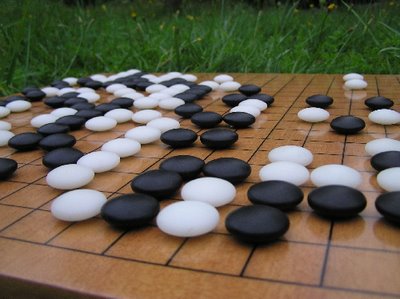The first lecture is on How to Invade. It gives rules of when invading is possible, and shows how to decide where to invade and how to follow up. In the process of invading, it also gives a lot of information on life and death. Yang has a multi step process on how to live and how to kill. I had heard about his killing process, but it was nice to see the rules on paper and explained more. It made more sense with the examples he gave as opposed to when I just heard the steps listed.
Lecture nr 2 was about Choosing the Right Pincer. This is similar to one of the chapters in his 'Fundamental Principles of Go'. This lecture seemed to go deeper (I don't have the fundamental book with me to compare, this is just from memory). He also talks about how to think and find the right move when your opponent plays a non-standard reply to the pincer. Interesting stuff and it explained why I got a bad result in a few recent games. It is nice to see so many things which are immediately applicable in one's games.

The third lecture is about side extensions in the opening. This lecture gave me a lot of new information. New tidbits to ponder about the opening. Over time, I have spent so many hours staring at board positions, trying to figure out what would be the best extension in that situation. This book will help me make better choices. This chapter, like all the others, is full of practical examples.
Fourth lecture is 'Playing a Territorial Game'. I know I am raving, but I am just amazed at the amount of information packed in a relatively small book. I have played territorial games where my opponent ended up with the whole center and I wasn't able to destroy it. This book gives me new tools and new ways to play territorial games, I can't wait to experiment with it.
Last lecture is the opposite subject with 'Playing a Moyo Game'. It gives a lot of guidelines for moyo games, how to play, how not to play. It shows a generous number of examples of how to deal with invasions in your moyo, and about correct and wrong direction of play. In both of these chapters, he stresses how important it is to be consistent, and not to switch back and forth between different styles of play. A good lesson to learn.
This book has so much information, it will take me a while to study and digest it all. I feel I only touched the tip of the knowledge in here during my first reading. It warrants sitting down with a goban and playing out the different variations. Over and over. I will take the book to go club with me today, will be good to complement our study session.

1 comment:
Thanks for the review.
Post a Comment